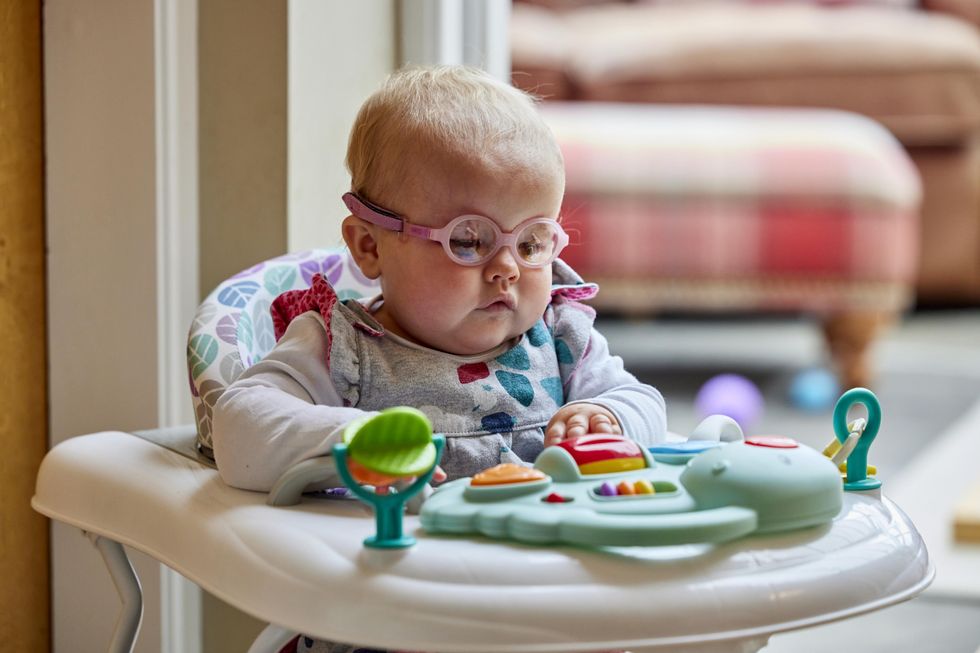Bilateral Anophthalmia In Newborns: Causes, Diagnosis, And Support

Table of Contents
Understanding the Causes of Bilateral Anophthalmia
The precise etiology of bilateral anophthalmia remains elusive in many cases, but research suggests a complex interplay of genetic and environmental factors.
Genetic Factors
Inherited genetic mutations play a significant role in the development of bilateral anophthalmia. Several genes have been implicated, and the inheritance patterns can be complex, including autosomal dominant, autosomal recessive, and X-linked inheritance.
- Examples of implicated genes: PAX6, SOX2, OTX2 (Note: Further research is ongoing, and this list may not be exhaustive.)
- Inheritance patterns: The inheritance of bilateral anophthalmia can vary greatly from family to family, making genetic counseling essential for affected families. Understanding the specific genetic mutation can help predict recurrence risks in future pregnancies. More research is needed to fully understand the complex genetic landscape associated with this condition.
- Genetic testing: Genetic testing can identify specific gene mutations responsible for bilateral anophthalmia in some cases, offering valuable information for families.
Environmental Factors
While genetic factors are prominent, environmental influences during pregnancy may also contribute to the development of bilateral anophthalmia. However, the exact mechanisms and the extent of environmental contributions remain unclear.
- Potential environmental risk factors: Exposure to certain medications during pregnancy, infections (e.g., rubella, toxoplasmosis), and other teratogens are potential contributing factors, although their precise roles require further investigation.
- Research limitations: Current research lacks definitive conclusions on the specific environmental triggers or the interactions between genetic predisposition and environmental factors in causing bilateral anophthalmia.
Unknown Etiology
In a significant number of cases, the cause of bilateral anophthalmia remains unknown, highlighting the complexities of this condition and the need for further research to elucidate its underlying mechanisms. This underscores the importance of comprehensive medical evaluations and genetic testing to identify any identifiable causes where possible.
Diagnosing Bilateral Anophthalmia in Newborns
Early diagnosis of bilateral anophthalmia is critical for enabling timely access to appropriate support and interventions.
Prenatal Diagnosis
Advances in prenatal imaging techniques offer possibilities for detecting bilateral anophthalmia before birth.
- Ultrasound: Ultrasound scans during pregnancy can sometimes detect the absence of the eyes, although the accuracy may vary depending on factors like gestational age and the expertise of the sonographer.
- Limitations of prenatal diagnosis: Prenatal diagnosis of bilateral anophthalmia isn't always conclusive. False positives or negatives are possible, and further investigations may be necessary after birth to confirm the diagnosis.
Postnatal Diagnosis
A thorough physical examination after birth is crucial for confirming the diagnosis of bilateral anophthalmia.
- Physical examination: The absence of both eye structures is the primary indicator. A careful examination by an ophthalmologist is essential to rule out other conditions and assess associated anomalies.
- Ophthalmological assessment: A detailed ophthalmological examination assesses the absence of eyes and other related developmental features. This forms the basis of a comprehensive diagnosis.
Further Investigations
Additional investigations are often necessary to determine the underlying cause and rule out other conditions.
- Genetic testing: Genetic testing can help identify specific gene mutations associated with bilateral anophthalmia, offering insights into potential recurrence risks and informing family planning.
- Other tests: Depending on the clinical presentation, other investigations might include brain imaging (MRI) to assess associated anomalies. Informed consent is crucial before undertaking any invasive procedures.
Support and Resources for Families Affected by Bilateral Anophthalmia
Receiving appropriate support is paramount for families dealing with the diagnosis of bilateral anophthalmia.
Emotional Support
The emotional impact on parents and families is significant. Access to emotional and psychological support is vital.
- Support groups: Connecting with other families facing similar challenges can provide invaluable emotional support and practical advice.
- Counseling services: Professional counseling can help families cope with the emotional and psychological aspects of this diagnosis.
- Peer-to-peer networks: Online forums and support networks provide opportunities to share experiences and build a sense of community.
Practical Support
Practical support is essential to navigate the complexities of raising a child with bilateral anophthalmia.
- Early intervention programs: Early intervention services can help maximize the child's developmental potential.
- Assistive devices: Prosthetic eyes can improve the child's appearance and self-esteem. Other assistive devices, such as sensory aids, are crucial for cognitive and social development.
- Educational support: Specialized educational support is crucial to ensure the child's academic success. Collaboration between families, educators, and healthcare professionals is essential for effective educational planning.
Long-Term Care and Planning
Long-term care planning requires a multidisciplinary approach to address the child’s evolving needs.
- Vision rehabilitation: Specialized programs address the challenges of visual impairment and promote adaptation and independence.
- Adaptive techniques: Strategies and techniques are essential to help the child develop essential skills and navigate daily life effectively.
- Ongoing medical monitoring: Regular medical checkups are crucial to address any health concerns and ensure ongoing well-being.
Conclusion
Bilateral anophthalmia presents unique challenges, but with early diagnosis, comprehensive support, and access to appropriate resources, families can navigate this journey successfully. Understanding the various causes of bilateral anophthalmia, the diagnostic process, and the importance of emotional and practical support is critical. If you or someone you know is affected by bilateral anophthalmia, seek professional advice and explore the numerous support networks and resources available. Learning more about bilateral anophthalmia support networks is crucial for providing families with the best possible care and ensuring a positive future for children living with this condition. Remember, early intervention and access to resources significantly influence the child’s quality of life.

Featured Posts
-
 John Wick 5 Officially Confirmed By Lionsgate What We Know So Far
May 11, 2025
John Wick 5 Officially Confirmed By Lionsgate What We Know So Far
May 11, 2025 -
 Nevero Aten Susret Okikj I Khart Vo Video Razgovor
May 11, 2025
Nevero Aten Susret Okikj I Khart Vo Video Razgovor
May 11, 2025 -
 Asylum Minister Defends Decision To Bypass Inspectorate On Legal Matters
May 11, 2025
Asylum Minister Defends Decision To Bypass Inspectorate On Legal Matters
May 11, 2025 -
 Tyreek Hill Vs Noah Lyles Michael Johnsons Expert Opinion On The Hypothetical Race
May 11, 2025
Tyreek Hill Vs Noah Lyles Michael Johnsons Expert Opinion On The Hypothetical Race
May 11, 2025 -
 Yankees Vs Brewers Whos On The Il March 27 30
May 11, 2025
Yankees Vs Brewers Whos On The Il March 27 30
May 11, 2025
Latest Posts
-
 Trumps Cheap Oil Agenda Conflicts And Compromises With The Energy Industry
May 12, 2025
Trumps Cheap Oil Agenda Conflicts And Compromises With The Energy Industry
May 12, 2025 -
 The Trump Presidency And Cheap Oil An Examination Of Policy And Impact
May 12, 2025
The Trump Presidency And Cheap Oil An Examination Of Policy And Impact
May 12, 2025 -
 Analyzing Trumps Approach To Cheap Oil And Its Effects On The Energy Sector
May 12, 2025
Analyzing Trumps Approach To Cheap Oil And Its Effects On The Energy Sector
May 12, 2025 -
 Trumps Energy Policy Balancing Cheap Oil With Industry Interests
May 12, 2025
Trumps Energy Policy Balancing Cheap Oil With Industry Interests
May 12, 2025 -
 The Paradox Of Trump And Cheap Oil A Critical Analysis
May 12, 2025
The Paradox Of Trump And Cheap Oil A Critical Analysis
May 12, 2025
